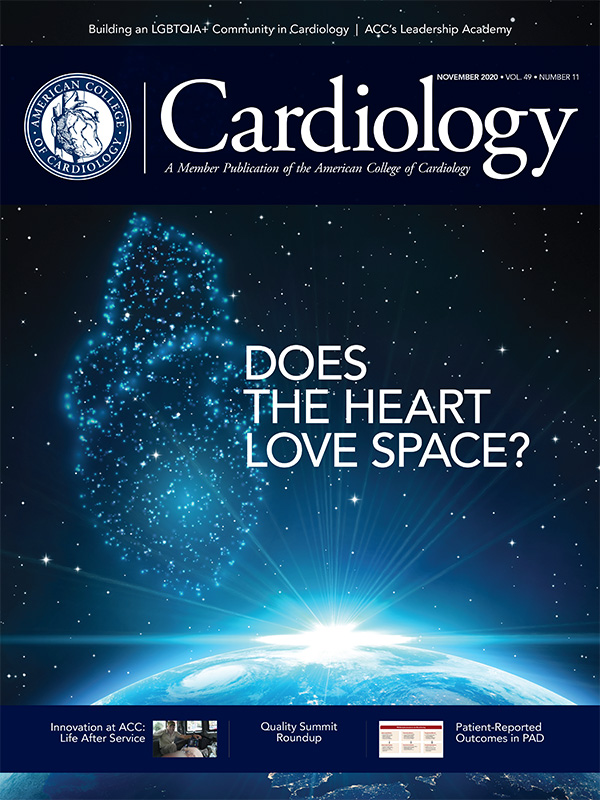Quality Improvement For Institutions | Diversity, Quality in COVID-19 Era, Improved Patient Outcomes Key Themes at ACC Quality Summit Virtual

ACC Quality Summit Virtual drew more than 3,200 attendees from 45 countries for two days of sessions focused on improving health care quality through NCDR, ACC Accreditation Services and quality campaigns. The meeting featured 23 educational sessions, 18 on-demand sessions, ePosters and a virtual Exhibit Hall with eight exhibitors.
This year's program centered on four main topic areas: diversity, equity and inclusion in the health care environment; providing leadership tactics to improve patient outcomes and cost savings; achieving advanced quality efforts to enhance patient outcomes; and evaluating quality care in the COVID-19 era.
The meeting kicked off on Thursday, Oct. 8 with the Ralph G. Brindis Keynote Lecture, featuring Quinn Capers IV, MD, FACC, whose talk, "Diversity and Inclusion in Health Care," set the tone for the meeting.
Capers outlined the reasons diversity in health care is important, including improved outcomes for minority patients, increased diversity in clinical trials and reduced racial health care disparities.
He also shared solutions – ranging from pipeline programs for students to enter medicine to considering diversity and cultural competency in admission, and from mentoring and recruiting minority students and providers to sharing successful efforts to increase diversity.
"We have documented it more than 300 times, but not much has changed," Capers said, speaking about research demonstrating cardiovascular health care disparities. "We keep documenting it and documenting it, but we're not changing these disparities. Those who think a lot about racial health disparities are convinced that one strategy to reduce or eliminate disparities is more diversity."
"We're living in very troubled times. Racism is killing people, and there is a global cry to end racism," he added. "Now is the time for our profession to fight racism, and one way to do that is to enhance diversity."
Early TRANSFORM: LDL-C Risk Results Announced

Preliminary findings from ACC's TRANSFORM: LDL-C Risk quality improvement initiative were released at Quality Summit Virtual. Early results suggest sharing a focused list of patients for guideline-informed actions to reduce atherosclerosis cardiovascular disease (ASCVD) may help to improve LDL control.
The TRANSFORM: LDL-C initiative engaged multiples sites enrolled in ACC's and Veradigm's PINNACLE Registry with a high proportion of adult secondary prevention patients with sustained LDL-C >100 mg/dL from June 2019 to March 2020. Eligible patients also had a prescription history for statins and/or ezetimibe.
Participating practices received a list of 20 to 400 eligible patients. Key components of the program included alignment of guideline-directed therapies with payer-related approval algorithms for patients eligible for potential treatment intensification; linking of practices with ACC Quality Ambassadors; access to targeted patient education materials, including a medication initiation plan; and in-person and online clinician education.
Based on early results in a subset of 220 patients for whom complete data were available, LDL-C values decreased by 23% and 18% of patients achieved an LDL-C <70 mg/dL. The majority of patients achieved these results through emphasis on current medical treatment. Only 7% required intensification with a PCSK9 inhibitor.
"These findings may indicate that the QI program proactively managing select patients had an impact on improved LDL control, but additional analysis will be needed with more complete patient data," said Thomas M. Maddox, MD, MSc, FACC, et al.
Maintaining Quality in the COVID-19 Era

COVID-19 was a focus throughout Quality Summit. In sessions focused on COVID-19, speakers shared how they quickly developed action plans as the pandemic began while maintaining high-quality cardiovascular services.
"COVID-19 has had a devastating impact on noncommunicable diseases as well," said Ty J. Gluckman, MD, FACC, Quality Summit chair and medical director of the Center for Cardiovascular Analytics, Research and Data Science at Providence Heart Institute in Oregon. "We've seen substantial drops in emergency department visits and hospitalizations that have been accompanied by partial or complete disruption of ambulatory care services."
In Mississippi, addressing COVID-19 required coordination across state health agencies and hospitals. For Dee M. Howard, BSN-RN, executive director of Mississippi Healthcare Alliance, this included considering how to treat patients in rural hospitals, where specialists or intensive care units are not always available, and addressing fears of virus exposure among patients with heart attack or stroke symptoms.
The solution involved having regional groups of pulmonologists available on call to assist with cases in rural areas and an awareness campaign, encouraging patients to call 9-1-1 when experiencing symptoms of a heart attack or stroke.
Speakers also discussed new processes of care for cardiovascular patients, including ensuring adequate supplies of personal protective equipment (PPE), creating non–COVID-19 zones, transporting patients, and implementing new guidelines for catheterization for STEMI and NSTEMI patients.
In addition, several ePosters explored how COVID-19 has affected cardiology practice over the last several months.
In one COVID-19 ePoster, researchers at Stroger Hospital of Cook County Health in Chicago, IL, analyzed data of heart failure (HF) patients admitted to the hospital with the coronavirus to determine which population had the greatest need for intervention.
They found that male, Black and white Hispanic HF patients may receive the most benefit from targeted education efforts about minimizing virus exposure, use of PPE, hand washing, and the need to isolate people with COVID-19 from other family members.
In another COVID-19 ePoster, researchers from Stony Brook University Hospital in New York interviewed cardiology patients to examine how post surge efforts to control and contain COVID-19 changed health care delivery and placed a burden on health care practitioners, systems and patients.
The most frequent concerns patients mentioned addressed communication with physicians and staff, prevention and limitation of visitors and hospital staff, as well as feelings of isolation and fears of COVID-19 infection.
The ability to meaningfully direct and decide on testing and treatments was strongly valued, particularly by patients feeling without control and hopeless. After discharge, patients strongly preferred going home over a rehabilitation or nursing facility and valued telehealth options for follow-up visits.
Improving Quality Through Accreditation

During Quality Summit, recipients of ACC's Accreditation Services 2020 Quality Initiative shared how their cardiovascular teams implemented changes to improve patient care and outcomes.
The Quality Initiative supports cardiovascular performance improvement initiatives at facilities that highlight the value of ACC cardiovascular services accreditation as part of overall clinical practice and quality.
The 2020 Quality Initiative recipients included:
Capture and Integration of Patient-Reported Health Status Measures to Optimize PCI Care
Steven M. Bradley, MD, MPH, FACC
Minneapolis Heart Institute at Allina Health
Minneapolis, MN
Improving Heart Health Through PACE: Patient-Centered Approach For Cardiac Rehab Enrollment
Andrea Price, MS, CPHQ, AACC, et al.
IU Health
Indianapolis, IN
Duke Renal Impairment Program (DRIP) Initiative
Sunil Rao, MD, FACC, et al.
Duke University Medical Center
Durham, NC
A System Approach to Closing Gaps in Guideline-Directed Medical Therapy For HFrEF
Roy W. Robertson, MD, FACC, et al.
Parkview Heart Institute
Fort Wayne, IN
Find Your Heart a Home Tool Expanded to Include ACC Accreditations, Certifications
ACC's Find Your Heart a Home tool has expanded to list ACC Accreditation and/or Certification products hospitals have earned. Patients and families can use the Find Your Heart a Home tool, powered by NCDR and CardioSmart to search, compare and select hospitals participating in NCDR and/or ACC Accreditation Services when making a decision on where to seek cardiovascular care.
Find Your Heart a Home Patient section includes patient resources on selecting a provider, preparing for visits and shared decision-making, while the Hospital section includes in-depth hospital and data reports.
Learn more at FindYourHeartaHome.org.
Spotlight on Research, Best Practices
The meeting also showcased new research with 76 ePosters that highlighted quality improvement successes at hospitals participating in NCDR, Accreditation Services or ACC's quality campaigns.
The top three posters chosen as award winners described how cardiovascular teams improved patient care and outcomes by reducing PCI bleeding, increasing referrals for cardiac rehabilitation (rehab), and decreasing 30-day readmissions for acute myocardial infarction (AMI).
The three winners presented oral abstracts explaining their projects. In First Place, Sara Belajonas, MSN, RN, et al., of Ocean Medical Center/Hackensack Meridian Health in New Jersey, explained how her team reduced PCI-associated bleeding with data from the CathPCI Registry and tools from ACC's Reduce the Risk: PCI Bleed quality campaign.
As part of the project, the team used ACC's CathPCI Bleeding Risk Calculator app to assess bleeding risk for all patients undergoing diagnostic cardiac catheterization and took steps to reduce bleeding based on each patient's risk.
Jerry Caldwell, RN, MSN, et al., received the Second Place award for their abstract on increasing referral and participation rates for outpatient cardiac rehab, which led to an improved defect-free care rate at Baylor Scott and White Medical Center-Temple in Texas.
The cardiovascular team accomplished this by adding an order set in the electronic health record that automatically populated cardiac rehab referrals for patients with AMI or unstable angina.
In addition, providers received training on the order set and an inpatient cardiac rehab program was implemented, allowing patients to begin an exercise program before hospital discharge.
The Third Place award went to Elizabeth A. Warren, RN, et al., for a project to reduce 30-day readmissions among AMI patients at UF Health Shands Hospital in Florida.
As part of ACC's Chest Pain Center Accreditation, the cardiovascular team implemented a transition of care pathway that focused on scheduling early follow-up appointments before patients were discharged and working with patients before they left the hospital to ensure they would be able to access and afford medications.
In addition, authors of three ePosters receiving Honorable Mentions – one each representing NCDR, Accreditation Services and ACC's quality campaigns – presented oral abstracts.
For the NCDR ePoster, Khalid Almuti, MD, FACC, et al., used data from ACC's ICD Registry to demonstrate that shorter hospital stays following ICD implantation may be feasible, safe and cost-effective.
Charyl T. Asuncion, MSN, et al., received the Accreditation Services Honorable Mention for increasing cardiac rehab referrals among PCI and MI patients as part of a process improvement project to earn Chest Pain Center Accreditation and Cardiac Cath Lab Accreditation.
Finally, the quality campaigns Honorable Mention went to Eleanor A. Rawls, MSN, for increasing patient engagement and reducing 30-day readmission rates among MI patients with a nurse navigator who was dedicated to MI patients.
Among other topics, ePosters also highlighted best practices from hospitals participating in ACC's Reduce the Risk: PCI Bleed and Patient Navigator Program: Focus MI quality campaigns.
The conference closed with the Annual Awards Ceremony, always a highlight of the meeting. During the ceremony, ePoster authors receiving awards or Honorable Mentions were recognized.
In addition, Phillip Levy, MD, MPH, FACC, chair of the Accreditation Oversight Committee, was named the recipient of the Raymond Bahr Award.
Votes for the People's Choice ePoster were tallied after the meeting and announced via email. That award went to Dylan Wilson, PharmD, BCPS, et al., of Jackson-Madison County General Hospital in Jackson, TN, whose poster was titled "Identification and Mitigation of Post-PCI Bleed Risk Factors With NCDR Data and PCI Bleed Risk Calculator."
Attendees can log in to the meeting site to view sessions and ePosters and claim continuing education credits through Jan. 9, 2021.
ACC Quality Summit 2021 is scheduled for Sept. 29 – Oct. 1, 2021, in Dallas, TX.
Address Health Disparities, Diversify Workforce to Achieve Quality Improvement

"We will never have high-quality care if we're treating different groups of people differently," said Quinn Capers IV, MD, FACC. An interventional cardiologist and professor of internal medicine and vice dean for faculty affairs at the Ohio State University College of Medicine, Capers delivered the Ralph G. Brindis Keynote Lecture at ACC Quality Summit Virtual on Oct. 8.
In his talk, titled "Diversity and Inclusion in Health Care," Capers discussed ACC's commitment to improve diversity and inclusion in the cardiovascular workforce and in ACC's leadership and membership. Capers has conducted research on diversity in medicine and leads training on implicit bias for clinicians.
He recently spoke with Cardiology about the role of diversity within the context of quality improvement and shared his thoughts on how to address health disparities and racism in medicine.
Why is diversity and inclusion important in the context of quality improvement?
Health care disparities – in which two demographic groups with the same medical problem get different treatment – is a major black eye in our health care system.
In cardiology, after documenting health care disparities for 30 years, we still have studies showing that Blacks, Hispanics and women do not get the same level of care as white male patients. This results in people suffering needlessly.
The reasons for this are multifactorial, but one is a lack of diversity in the cardiology workforce. Research shows that physicians who come from backgrounds that are underrepresented in medicine or physicians of any race from socioeconomically disadvantaged backgrounds are more likely to serve disadvantaged populations.
There is also evidence that minority patients – in part because of mistrust of the health care system from years of mistreatment – are more likely to consent to vaccinations and major surgeries if the recommending physician shares their background.
One of the most important things we can do to improve quality is to diversify the physician workforce.
The issue of health disparities has been more visible since the COVID-19 pandemic began. Do you think disparities will continue to be part of the national conversation?
I do. COVID-19 didn't cause health disparities, but it put a spotlight on the social determinants of health and how people with fewer resources are at a disadvantage when they don't have a primary care physician, the means to get tested or the ability to take off work.
If we have a vaccine and COVID-19 becomes a thing of the past, it is certainly my hope that we won't ignore the issues that were put under the spotlight during the pandemic.
There is a global call to end racism and racist policies and structures that allow people to live so differently and receive different levels of treatment. Medicine must heed that call, too, by dismantling the structures that have led to a lack of diversity in medicine for so long and by treating all people fairly and equitably.
Racism is a public health issue. Just as we are working feverishly to develop a vaccine to treat COVID-19, I would love to see us working to reduce the impact of racism and bias in medicine, because that also results in the loss of too many lives.
Racism in medicine was here long before COVID-19 and if we don't do something about it, it will be here after COVID-19.
How can an individual clinician address health disparities in their daily work?
I'm a big fan of clinical protocols. When I was trainee, I thought protocols were cookbook medicine. If your patient has this, you do that, then go to the next step. My feeling was "The doctor has spent years gaining an understanding of pathophysiology and shouldn't have to follow a cookbook."
However, it turns out that when treatment decisions are left to the doctor's discretion, we wind up with racial and gender health care disparities. I've come around in my thinking about the value of clinical protocols.
The individual clinician can make sure to follow those protocols. If we know that the best practice is for heart attack patients to receive aspirin and a beta-blocker, then every heart attack patient needs to get those medications.
There are still studies showing that women and Black patients discharged from the hospital with a heart attack were less likely than white men to be discharged on these medications. Similar studies have shown racial disparities in the use of lifesaving defibrillators, stents and bypass surgery.
At the individual level, clinicians need to bring their best selves to patient interactions. We all have unconscious biases. If in a physician's unconscious mind, based on prior experiences, they associate young white women with compassion, old white men with wisdom and young black men with danger, these implicit biases might influence them to treat these patients differently. Individual practitioners can take online tests to determine their implicit biases, and there are strategies to reduce and overcome them.
How can quality improvement efforts help address disparities?
We tend to have a competitive spirit in medicine. I think coming up with ways that show how one medical center is performing compared with another medical center can help. Are mortality rates higher? Are Blacks less likely to get a beta-blocker at one hospital vs. another? Recording and reporting that kind of data can go a long way. No one wants to be in last place or in the bottom decile.
Report cards and benchmarking will help. Are all races at "Hospital A" getting the same quality of care? How about at "Hospital B"? For hospitals that show unexplained racial and gender disparities in care, we need to have strategies to help them achieve equity. There must also be accountability and consequences. This is one way that quality improvement processes can address disparities.
Clinical Topics: Cardiovascular Care Team, COVID-19 Hub, Dyslipidemia, Prevention, Lipid Metabolism, Nonstatins, Novel Agents, Statins
Keywords: ACC Publications, Cardiology Magazine, COVID-19, Pandemics, Hydroxymethylglutaryl-CoA Reductase Inhibitors, Quality Improvement, Patient Readmission, Cardiac Rehabilitation, Physician Executives, Cholesterol, LDL, Capparis, Cost Savings, Secondary Prevention, Leadership, Cardiovascular Diseases
< Back to Listings

